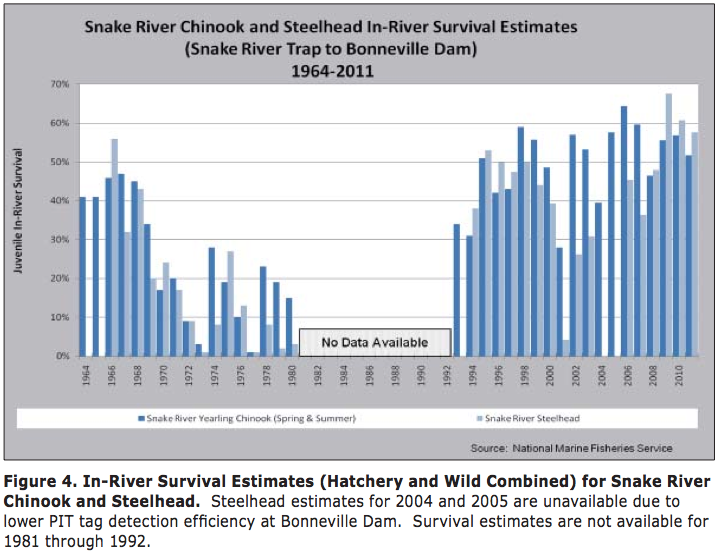forum
library
tutorial
contact

Adult Salmon Survival
Past Dams is 99 Percent
by John McKern
Walla Walla Union-Bulletin, March 25, 2015
|
the film forum library tutorial contact |

|
Adult Salmon Survival
by John McKern
|
 Borg Hendrickson from Idaho believes my claims of over 99 percent adult salmon survival and over 95 percent juvenile survival past each lower Snake River dam are false and misleading.
Borg Hendrickson from Idaho believes my claims of over 99 percent adult salmon survival and over 95 percent juvenile survival past each lower Snake River dam are false and misleading.
University of Idaho researchers, contracted by the U.S. Army Corps of Engineers, radio-tracked adult spring Chinook from Ice Harbor Dam to their spawning areas up to 100 miles beyond Lewiston.
Average survival was over 99 percent. Claiming 99 percent survival of adults past each dam is therefore very conservative.
Project survival includes survival past each dam and through its reservoir. I said juvenile salmon survival past each dam is over 95 percent.
I did not discuss reservoir survival.
(bluefish notes: Yes, and it is rare that a dam supporter admits this important omission -- not discussing reservoir survival -- as if somehow it is unimportant to the discussion.)
Borg says NOAA Fisheries estimated a 10-year average of 59 percent survival from Lower Granite Dam to below Bonneville Dam.
Borg's parsing 59 percent to per project survival yields 93.6 percent which, given some reservoir mortality, supports the 95 percent per dam survival.
Achieving high dam survival has taken a long time and investment of hundreds of millions of dollars for research and structural improvements by the Corps.
Borg discussed smolt-to-adult return rates (SARs) SARs are the number of passive integrated transponder tagged adults detected at a point divided by the number of tagged smolts detected passing that point one to four years earlier. Lower Granite Dam is where most Snake River salmon SARs are measured.
Transporting juvenile salmon from Lower Granite to below Bonneville Dam consistently gives over 98 percent smolt survival. Based on SARs for tagged juveniles transported from Lower Granite divided into the resulting number of known tagged adults that return to Lower Granite, transport SARs usually exceed in-river SARs.
In-river SARs are roughly estimated because most juvenile salmon are not tagged.
NOAA Fisheries estimates how many smolts pass Lower Granite Dam in-river then divides that number into the number of returning adults from smolts that were not transported.
Historically (aka. long ago) over harvest in the river and ocean and habitat loss by agriculture, logging, or by dams like Lewiston Dam, Sunbeam Dam, the Hells Canyon, Oxbow, Brownlee complex, and other private dams in Idaho drove ESA listing.
Predation by thousands of outgoing juveniles by birds, and incoming adults by seals and sea lions in the lower Columbia greatly reduce the numbers of returning adults.
Improved smolt survival is being offset by poor lower river and ocean survival, and though SARs remain low, higher adult returns are coming again in 2015.
Related Pages:
Fish Survival Rate is Disputed by Borg Hendrickson, Walla Walla Union-Bulletin, 3/21/15
Hydropower Not Been Replaced by Wind Power by John McKern, Walla Walla Union-Bulletin, 3/6/15
New Numbers Won't Change Debate About Snake River Structures by Rocky Barker, Idaho Statesman, 3/5/15
Lower Snake River Dams Are Economic Losers Borg Hendrickson, Walla Walla Union-Bulletin, 2/28/15
learn more on topics covered in the film
see the video
read the script
learn the songs
discussion forum
